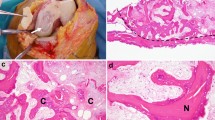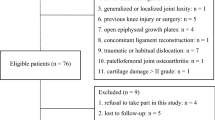Abstract
After the treatment of patella fractures the only way to evaluate healing at the articular surface before implant removal is through arthroscopy. The purpose of this study was to examine the healing potential of the cartilage. Arthroscopy was performed in 18 patients at the time of implant removal. The mean age of the patients was 42.1 years. The time elapsed from the index surgery to the arthroscopy and implant removal surgery was 12.9 months. During the arthroscopy, we inspected articular step-off, cartilage loss, and joint surface irregularities. Cartilage irregularities were observed in 13 of the 18 patients. Five patients had well-healed cartilage at the patellar surface. Although none of the patients had displacement at final follow-up X-rays, step-off was detected in two patients during arthroscopy. Our observation showed that cartilage lesions did not correlate with clinical and radiological evaluation. Despite good knee scores, we observed surface irregularities, chondral lesions, and fibrillation in most of the cases implicating subsequent patellofemoral arthritis.
Résumé
La seule façon d'évaluer la cicatrisation de la surface articulaire après traitement de la fracture de la rotule est l'arthroscopie. Le propos de cette étude est d'examiner le potentiel de cicatrisation du cartilage. une arthroscopie a été réalisée chez 18 patients après fracture de la rotule au moment de l'ablation de matériel. L'âge moyen de ces patients était de 42,1 ans. Le temps écoulé entre la chirurgie et l'arthroscopie au moment de l'ablation de matériel a été de 12,9 mois. Durant l'arthroscopie, le cartilage a été analysé surtout en terme d'irrégularités et de pertes de substances. des irrégularités cartilagineuses ont été observées chez 13 patients sur 18. 5 patients sur 18 ont un cartilage qui a parfaitement cicatrisé en surface. Cependant, aucun de ces patients n'avait de déplacement. A la fin du suivi radiologique, une marche d'escalier a été observée chez 2 patients sur les 18 ayant bénéficié de l'arthroscopie. nos observations permettent de montrer que la lésion cartilagineuse n'est pas corrélée à la symptomatologie clinique et radiologique. Cependant, des patients ayant un bon score au genou, peuvent présenter des irrégularités de surface cartilagineuse avec lésions chondrales de fibrillation dans la plupart des cas et peuvent à terme évoluer vers une athrose fémoro-patellaire.






Similar content being viewed by others
References
Benjamin J, Bried J, Dohm M, McMurthy M (1987) Biomechanical evaluation of various forms of fixation of transverse patellar fractures. J Orthop Trauma 1:219–222
Carpenter CE, Kasman RA, Patel N, Lee ML, Goldstein SA (1997) Biomechanical evaluation of current patella fracture fixation techniques. J Orthop Trauma 11:351–356
Cetik O, Cift H, Asik M (2007) Second-look arthroscopy after arthroscopy-assisted treatment of tibial plateau fractures. Knee Surg Sports Traumatol Arthrosc 15(6):747–752
Lefkoe TP, Walsh WR, Anastasatos J, Ehrlich MG, Barrach HJ (1995) Remodeling of articular step-offs. Is osteoarthrosis dependent on defect size? Clin Orthop Relat Res (314):253–265
Lotke PA, Malcolm LE (1981) Transverse fractures of patella. Clin Orthop 158:180–184
Lysholm J, Gillquist J (1982) Evaluation of knee ligament surgery results with special emphasis on use of a scoring scale. Am J Sports Med 10:150–154
Marsh JL, Buckwalter J, Gelberman R, Dirschl D, Olson S, Brown T, Llinias A (2002) Articular fractures: does an anatomic reduction really change the result? J Bone Joint Surg Am 84-A(7):1259–1271
Marya SKS, Surya B, Dave PK (1987) Comparative study of knee function after patellectomy and osteosynthesis with a tension band wire following patellar fractures. Int Surg 72:211–213
May Z, Zhang YF, Qu KF, Yeh YC (1984) Treatment of fractures of patella with percutaneous suture. Clin Orthop 191:235–242
Tandogan RN, Demirors H, Tuncay CI, Cesur N, Hersekli M (2002) Arthroscopic-assisted percutaneous screw fixation of select patellar fractures. Arthroscopy 18(2):156–162
Weber MJ, Janecki CJ, Mc Leod P, Nelson CL (1980) Efficacy of various forms of fixation of transverse fractures of the patella. J Bone Joint Surg Am 62:215–220
Author information
Authors and Affiliations
Corresponding author
Rights and permissions
About this article
Cite this article
Haklar, U., Kocaoglu, B., Gereli, A. et al. Arthroscopic inspection after the surgical treatment of patella fractures. International Orthopaedics (SICOT) 33, 665–670 (2009). https://doi.org/10.1007/s00264-008-0548-5
Received:
Revised:
Accepted:
Published:
Issue Date:
DOI: https://doi.org/10.1007/s00264-008-0548-5




